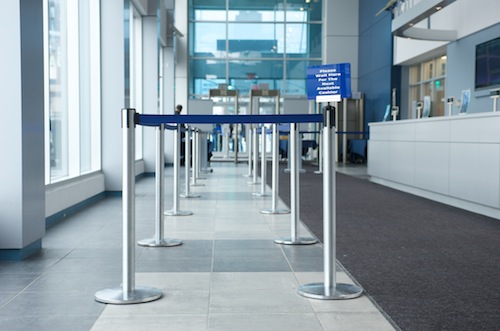Some might assume that their crowd control options are limited to a standard configuration of posts, ropes, and stanchions but that’s simply not the case.
There are actually three very distinct ways to utilize your equipment of choice. All three methods have their own advantages. Determining which queue system to use for your business is entirely up to you. When you’re exploring the various options, make sure to consider the amount of space you’re working with, the unique needs and demands of your environment and your line management budget.
Here’s an overview of the most utilized types:
Standard Linear Queuing
This describes your “standard” setup or queue system where you have a separate line for each service desk or cashier.
Advantages
• Customers can choose to join the shortest queue
• Customers can move to another queue if they are held up by a slow customer
• Minimizes wait time between two customers because the next person is always waiting & prepared]
• Servers / cashiers tend to operate faster when they are responsible for their own line
Possible Disadvantages
• The system can be unfair as a customer that joins a queue later may be served before you
• Customers experience uncertainty and anxiety over which queue to join
• People are focused on monitoring the lines rather than in queue merchandise
Single Line Queuing
Also known as a Call Forward System, this queue system groups customers into one single line that feeds to multiple service areas or cash registers. Typically, service personnel have individual stations that are part of one long counter or desk. Stanchions may be numbered and digital signage may be utilized to let the customer at the head of the line know which station to approach. This system can be set up with any type of stanchions, as long as a single line is formed.
Advantages:
• No uncertainty about which queue to join
• No unfairness – it’s always a first come, first served situation
• Eliminates customers selecting their cashier, which may reduce employee theft or selective item scanning for friends
• Increases flexibility when adding or changing staff
Possible Disadvantages:
• Walk times from the head of the queue to the service desk
• Hesitation time due to customer uncertainty about which desk is free and when to approach (this issue is eliminated with a call forward system)
Dispersed or “Virtual” Queuing
This type of queue management disperses waiting crowds with a ticketing system. Think of the deli counter in a supermarket, where everyone takes a ticket and then stands back until their number is called.
This system is typically used for councils, hospitals, pharmacies, specialty food counters, shoe stores and banks.
Advantages:
• Allows multiple transaction profiles to be handled fairly and impartially for all waiting customers
• Customers feel less restricted and more comfortable as they’re waiting
• The system allows customers to browse and shop while they wait, which increases impulse purchases
• A sign-in kiosk makes it easy to assign the correct member of staff based upon your customers requests
• New technology gives retailers and staff the opportunity to communicate directly with customers via an LCD screen or text messaging
Possible Disadvantages
• Paper tickets be wasteful and customers may not dispose of them correctly
• Customers may be confused on what to do/where to go
• Less technologically savvy people may be overwhelmed with an advanced system
Once you choose the type of line management you’d like to go with there are tons of posts, ropes and stanchions to choose from. There are also several different ways to implement a successful and efficient version of each kind of setup. There’s a lot to consider when you’re figuring out how to best manage your customers but we hope this general overview of queue system options gets retailers and service providers off to a solid start.
If you have any questions about these systems or where to begin, feel free to comment here or get in touch.

